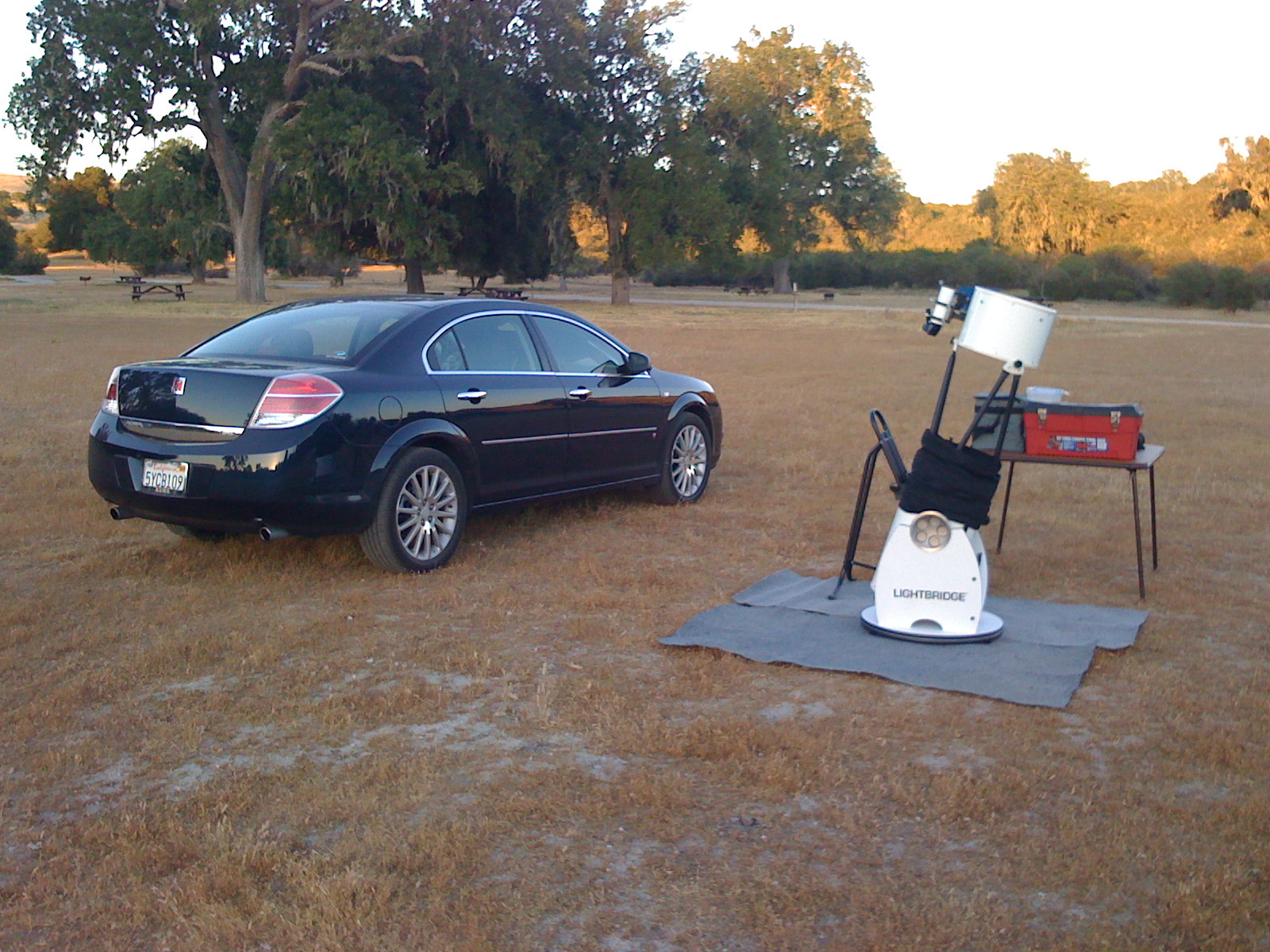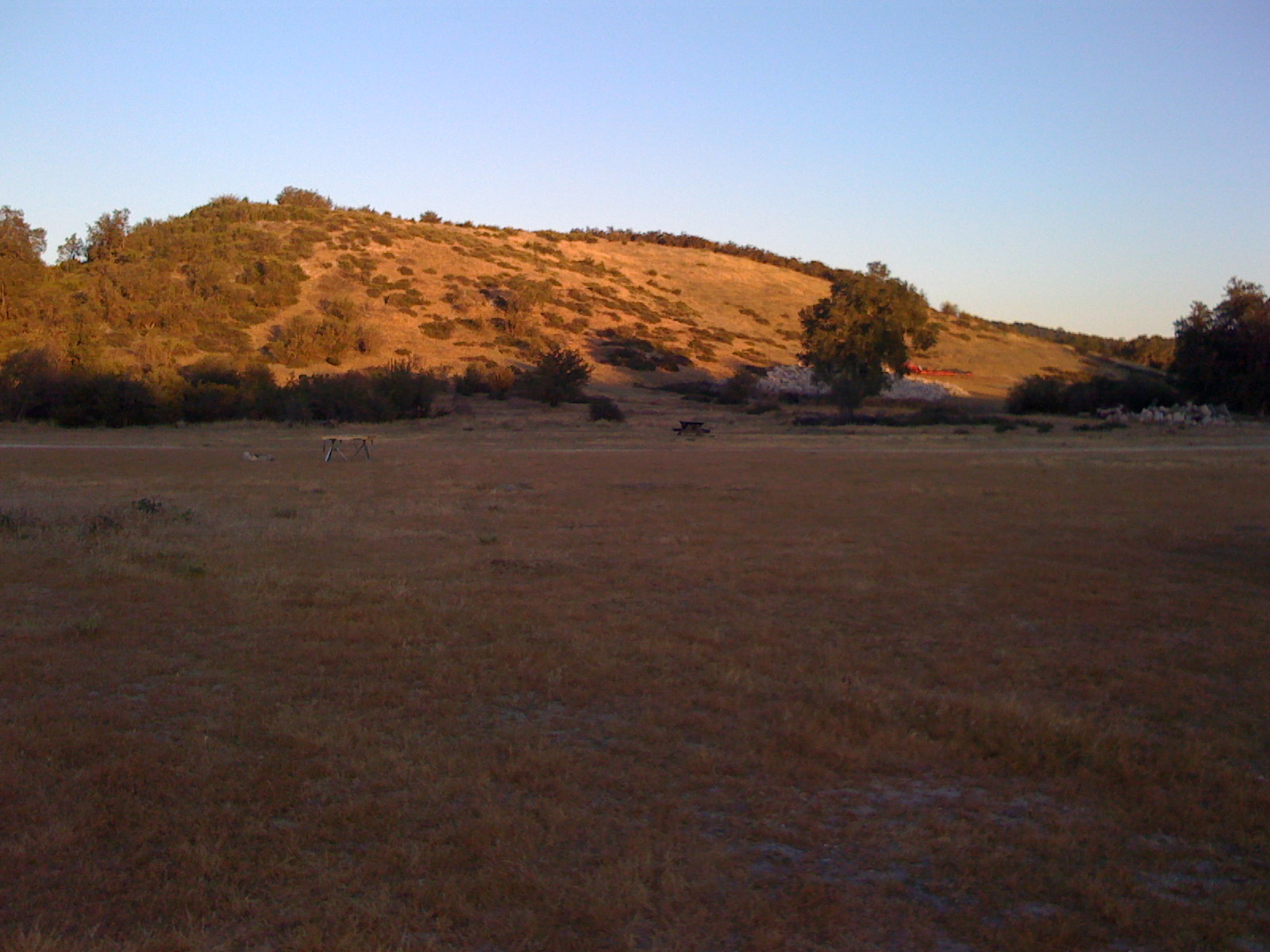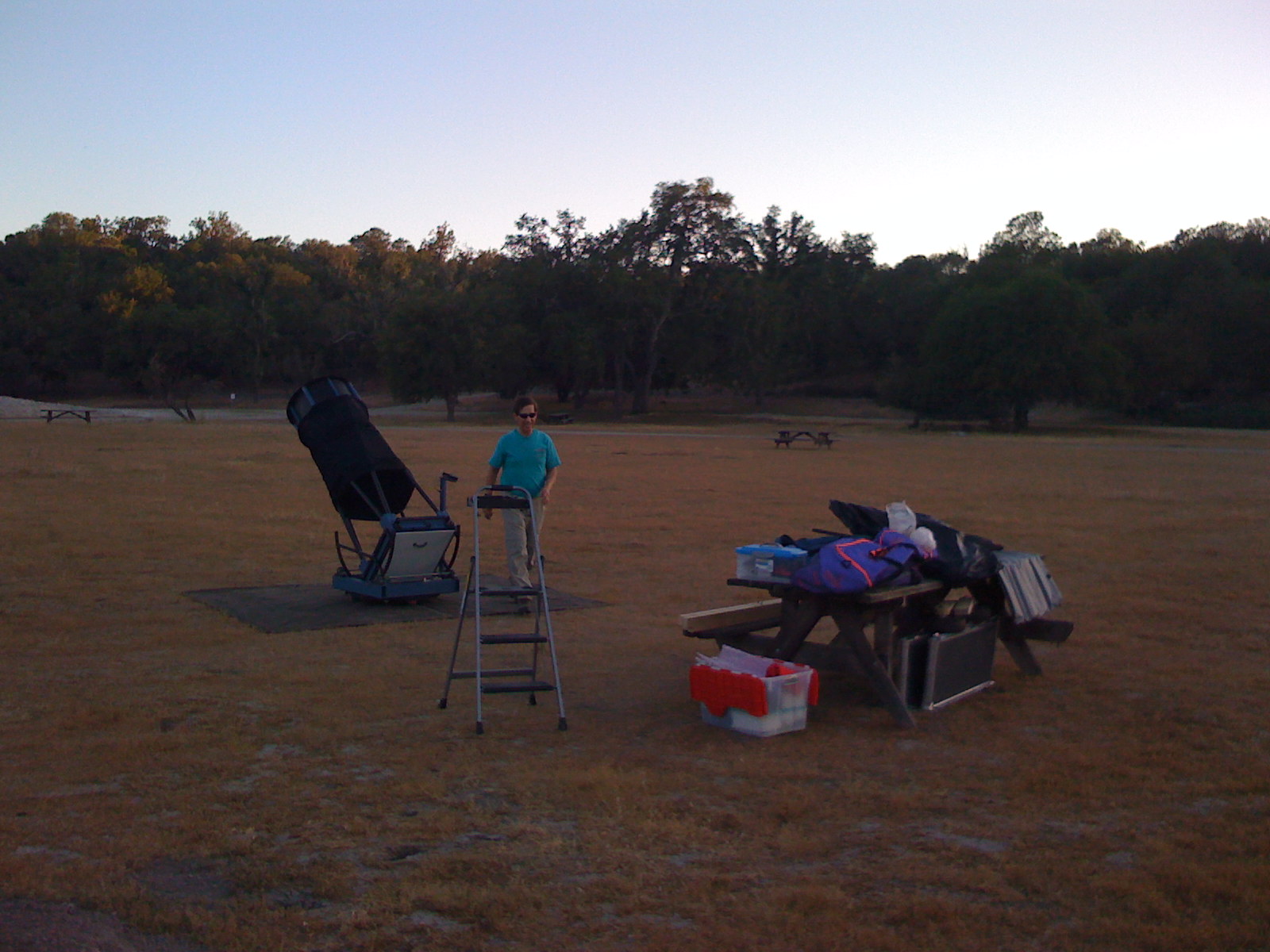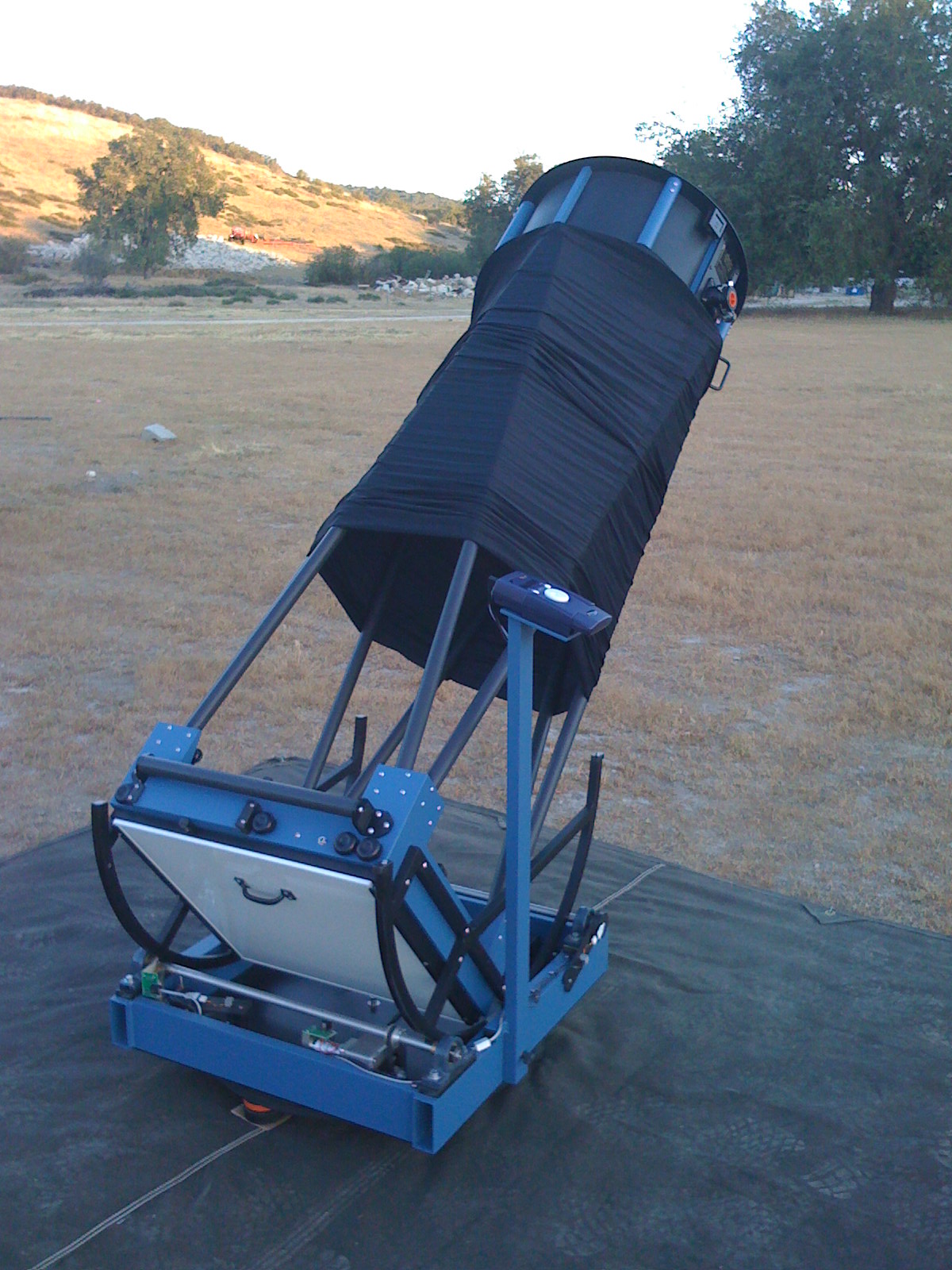On Tuesday morning, when I looked at the Clear Sky Clock, I noticed that the observing conditions were going to be ideal for that night: excellent transparency, good to excellent seeing, and no wind. Therefore, after much consideration, I decided to cancel my weekend trip to the D.A.R.C. observatory, and instead head to Lake San Antonio for a mid-week outing.
The drive to Lake San Antonio is rather long (2h20m) but fairly pleasant, especially the last 50 miles. The temperature was very comfortable (low 80s/high 70s), and the traffic was very light on Highway 101.
Once I arrived at the overflow campground, I was delighted to see that Jim Molinari had decided to join me. Jim brought his SpicaEyes 20″ F/4 dobsonian telescope I had heard of this brand before, but had never seen one myself. All I can say is that it looks like a solidly built (all powder-coated aluminum) fine piece of equipment, with lots of nice accessories (primary mirror thermometer, no clutches to engage/disengage the tracking system, etc.)
I proceeded to setup my equipment, only to realize a few minutes later that a large number of ants were passing through the area. I quickly moved my scope a little further in an ant-free area. Next time, I’ll have to think about bringing some insect killer to spray around my observing mat.
“Diehard Rogelio” showed up around 10pm to image a couple of southern targets located barely above the treeline, too low to capture from the bay area.
Early on, the seeing was a little soft, but the transparency was good. The light domes from King City and Paso Robles were barely visible, and the sky was truly dark. I had brought with me a chart of the big dipper labelled with star magnitudes. I was able to see, using averted vision, a star of 7th magnitude. Unfortunately, my chart was not showing stars fainter than 7th magnitude, so I cannot tell for sure what the naked eye limiting magnitude was, but the sky felt a little bit darker than at the D.A.R.C. observatory (not much darker though, maybe one or two tenth of a magnitude…) The seeing improved a bit as the night went on, and became quite good, although not excellent, after 1am. The temperature dropped surprisingly low, down to 38F at 3:30am. Good thing I had brought warm clothes!
I kept very busy all night, and managed to observe all the Herschel 400 targets I had on my list. Besides my “boring” prepared list, I got to see the Centaurus A galaxy (a.k.a. the “hamburger galaxy”) for the first time. Although very low above the horizon, the dark lane splitting this galaxy in half was pretty well defined, showing faint patches inside. This galaxy must be spectacular when seen from the southern hemisphere!
I feel like my star hopping abilities are getting better every time I go out. I really enjoy matching what I see in the finder scope with Uranometria, and finding the object I am looking for right in the middle of the field of view of my 16mm Nagler eyepiece. It’s like a “human goto”, only slightly slower (and quieter!)
Jim had brought his MallinCam color video camera, along with a small LCD screen. It was really astonishing to see a real time “video” (using short 7 second exposures) of NGC 3628 and M 51, and compare with views through the eyepiece.
I called it a night around 3:30am, slept for a few hours, and took off shortly after sunrise. I was home by 10am. Overall, I was very pleased with the sky at Lake San Antonio. However, I won’t be going there very often for one night only, mainly because of the long drive. Also, if you factor in the price of gaz and the campground fees, it amounts to almost $60. Finally, I was extremely tired all day on Wednesday, making for some interesting meetings at work… However, I can guarantee I will be going to CalStar this year!
Note regarding observation logging: I feel like my logging is improving in coverage and accuracy every time I go out. When I prepare an observation, I don’t like to look at photographs of the objects beforehand. I feel like it may affect what I document in my log, and not necessarily in a positive way. However, when I enter my log into SkyTools, I really enjoy matching what I saw with actual photographs. Most often, it matches pretty well. Sometimes, it matches beautifully as in the case of planetary nebula NGC 4361 (see log below), and some other times, it does not match at all, in which case I mark the object as “re-observe”. I also enjoy looking at the magnitude of the superimposed stars I was able to see. One of them for example (see NGC 4697 below) is of magnitude 15.3. A month ago, at D.A.R.C., under exceptional conditions, I was able to go as deep as magnitude 15.6! Not bad for a rookie using a 12″ scope!
Location: Lake San Antonio [Elevation 1082 ft]
Telescope: Meade Lightbridge 12″ F/5
Eyepieces used:
- Televue Panoptic 27mm (56x - 1.2° TFOV)
- Televue Nagler 16mm type 5 (95x - 52′ TFOV)
- Televue Nagler 9mm type 6 (169x - 29′ TFOV)
- Televue Nagler 7mm type 6 (217x - 22′ TFOV)
- Televue Nagler 5mm type 6 (305x - 16′ TFOV)
(All times are PDT)
NGC 2419 (Intergalactic Wanderer) GC Lyn 07h38m46.2s +38°51’45″ 10.3 mag 09:40p
Faint, round, unresolved, progressively brighter core at 95x. Remains unresolved, but starts displaying a mottled appearance at higher magnification.
NGC 2683 GX Lyn 08h53m16.7s +33°23’14″ 10.0 mag 09:45p
Moderately large, fairly bright, elongated 5×1 NE-SW, gradually brighter core. Fairly bright superimposed star (mag 13) 2′ NE.
NGC 2782 GX Lyn 09h14m41.9s +40°04’34″ 12.3 mag 10:05p
Very small, very faint halo, fairly faint small but non-stellar core.
NGC 3379 / M 105 GX Leo 10h48m20.5s +12°31’52″ 10.2 mag 10:15p
Moderately large, very bright, broad central concentration. Uniform roundish halo, only very slightly elongated E-W. Forms a beautiful triplet with NGC 3384 and NGC 3389.
NGC 4361 PN Crv 12h25m01.6s -18°50’27″ 10.9 mag 10:25p
Moderately large planetary nebula, fairly bright, easily spotted at 95x. At 169x, it looks round, very slightly elongated NE-SW. The central star (mag 11.5) was seen easily using direct vision. At high magnification, using a UHC filter and averted vision, I started spotting delicate variations in brightness. This nebula seemed to be made of two “bars” centered on the central star. One is elongated 2×1 E-W, and the other is elongated 3×1 NE-SW. This impression was beautifully confirmed by looking at a DSS image.
NGC 5054 GX Vir 13h17m30.1s -16°41’13″ 11.6 mag 10:50p
Moderately large, fairly faint, uniform halo, elongated 2×1 N-S, gradually brighter to a stellar nucleus. There is a really nice group of 5 galaxies 15′ WNW, forming a circle.
NGC 4856 GX Vir 12h59m52.7s -15°05’48″ 11.4 mag 11:00p
Fairly small and fairly bright, with a halo elongated 3×1 NE-SW. Broad central concentration. Moderately bright superimposed star 30″ SE. Very faint superimposed star 2′ NE.
NGC 4594 / M 104 (Sombrero Galaxy) GX Vir 12h40m30.2s -11°40’41″ 9.1 mag 11:10p
Fairly large, very bright, elongated 3×1 E-W. Dark lane crossing the galaxy. Northern half looks much larger and brighter, with a very bright broad central concentration. The southern half is barely visible. Fairly bright star just 2′ N.
NGC 4781 GX Vir 12h54m54.7s -10°35’27″ 11.4 mag 11:20p
Moderately large, moderately bright, elongated 3:2 WNW-ESE, fairly uniform, very slight brightening in the middle. Fairly faint superimposed star 2′W. Forms a tight couple with fainter and smaller NGC 4784.
NGC 4699 GX Vir 12h49m33.1s -08°43’08″ 10.4 mag 11:30p
Fairly small, very bright, elongated 3:2 NNE-SSW. Small elongated core. I thought I saw two broad spiral arms, but a DDS image shows that this spiral is tightly wound.
NGC 4958 GX Vir 13h06m19.7s -08°04’25″ 11.5 mag 11:35p
Fairly small, pretty bright, elongated 3×1 NNE-SSW. Fairly broad central concentration.
NGC 4995 GX Vir 13h10m12.0s -07°53’07″ 11.9 mag 11:45p
Fairly small, fairly faint, very uniform, elongated 4:3 E-W, tiny nucleus. I noted a very faint superimposed star 2′ E. However, a 2′ angular distance would not make this a superimposed star. Moreover, there is a very faint (mag 15.4) star about 1.5′ E, and another one (mag 15.4) only 30″ E. I’m not sure which one I saw.
NGC 4697 GX Vir 12h49m06.7s -05°51’19″ 10.1 mag 11:50p
Pretty bright, moderately large, elongated 2×1 ENE-WSW. Fairly large central concentration. Very faint superimposed star (mag 15.3) about 1.5′ E.
NGC 4546 GX Vir 12h36m00.1s -03°50’52″ 11.3 mag 12:15a
Fairly small, pretty bright, elongated 5:2 E-W, small non-stellar core.
NGC 4030 GX Vir 12h00m53.6s -01°09’20″ 11.2 mag 12:30a
Moderately large, moderately bright, appears round at first, with a gradually brighter core. Framed by 3 fairly bright stars (magnitude 11.1, 11.5 and 13.7) I noted hints of 2 barely visible spiral arms going counter-clockwise.
NGC 4666 (Superwind Galaxy) GX Vir 12h45m39.2s -00°30’57″ 11.5 mag 12:40a
Elongated 5×1 NE-SW, with an elongated core. Forms a nice field of view with much fainter and smaller NGC 4668.
NGC 4753 GX Vir 12h52m52.7s -01°15’13″ 10.9 mag 12:45a
Moderate size, fairly bright, elongated 3:2 E-W, gradually brighter core to an almost stellar nucleus.
NGC 5634 GC Vir 14h30m08.7s -06°01’17″ 9.5 mag 12:50a
Fairly small, pretty bright, located at the base of an isosceles triangle formed by 3 fairly bright stars. At 300x, using averted vision, this globular cluster appears slightly mottled.
NGC 4550 GX Vir 12h36m00.7s +12°10’03″ 12.5 mag 01:05a
Fairly small and bright, elongated 3×1 N-S, with a relatively large, elongated core. Forms a tight couple with NGC 4551.
NGC 4548 / M 91 GX Com 12h35m56.5s +14°26’35″ 10.9 mag 01:15a
Large, round and faint halo. Embedded in it is a bar elongated 3×1 E-W, with a bulge in the middle, corresponding to the core of the galaxy. No trace of the beautiful spiral arms seen in photographs.
NGC 4459 GX Com 12h29m30.1s +13°55’30″ 11.4 mag 01:25a
Fairly small, bright and round, with a relatively large core and a stellar nucleus. Located 2′ NNW of a very bright star (magnitude 8.7)
NGC 4689 GX Com 12h48m15.7s +13°42’33″ 11.6 mag 01:35a
Moderately large, very pale, very uniform, elongated 4:3 N-S. Tiny very faint nucleus glimpsed at higher magnifications.
NGC 4477 GX Com 12h30m32.3s +13°34’59″ 11.3 mag 01:40a
Very faint round halo, elongated core 2×1 N-S. Forms a nice tight couple with smaller NGC 4479.
NGC 4473 GX Com 12h30m19.0s +13°22’33″ 11.1 mag 01:50a
Fairly small and bright, elongated 2×1 E-W, sharply defined non-stellar core.
NGC 3945 GX UMa 11h53m45.8s +60°37’33″ 11.7 mag 01:55a
Small, moderately bright, round, with a relatively large and well defined core and a very faint stellar nucleus. Photographs show an outer ring elongated 2×1 NNE-SSW.
NGC 3665 GX UMa 11h25m15.7s +38°42’44″ 11.8 mag 02:00a
Small, moderately bright, round halo, elongated core 3:2 NNE-SSW, stellar nucleus.
NGC 4800 GX CVn 12h55m05.9s +46°28’51″ 12.3 mag 02:15a
Fairly small, moderately bright, elongated 3:2 N-S, gradually brighter core. Fairly bright star (mag 13.2) about 1.5′ W.
NGC 5005 GX CVn 13h11m24.4s +37°00’29″ 10.5 mag 02:20a
Fairly large and bright, elongated 3×1 E-W, with a bright elongated, fairly large and well defined core.
NGC 5033 GX CVn 13h13m55.6s +36°32’37″ 10.7 mag 02:25a
Fairly large, moderately bright, elongated 2×1 N-S, with a small, bright and well defined core. Fairly bright (mag 13.9) superimposed star 1.5′ N.
NGC 5273 GX CVn 13h42m35.6s +35°36’22″ 12.5 mag 02:35a
Fairly small, very pale, round halo, tiny almost stellar nucleus.
DSL | Toronto tree service in Canada | galajurk



